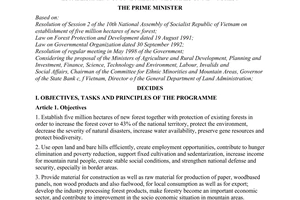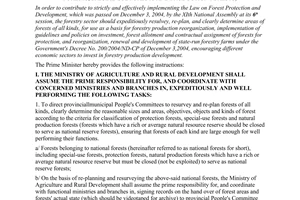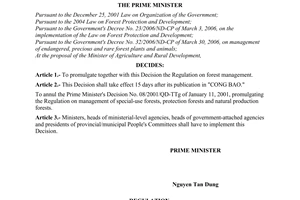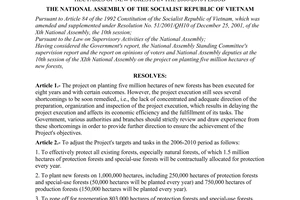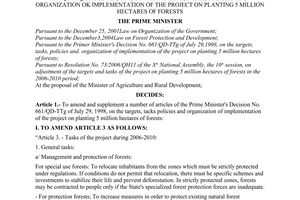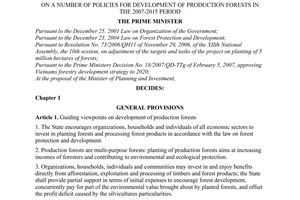Nội dung toàn văn Joint Circular No. 58/2008/BNN-BKHDT-BTC of May 02, 2008, guiding the implementation of the prime minister’s decision on objectives, tasks, policies and organization of implementation of the five million hectares afforestation project in the 2007-2010 period
|
THE
MINISTRY OF AGRICULTURE AND RURAL DEVELOPMENT- THE MINISTRY OF PLANNING AND
INVESTMENT - THE MINISTRY OF FINANCE |
SOCIALIST
REPUBLIC OF VIETNAM |
|
Hanoi, May 2, 2008 |
JOINT CIRCULAR
GUIDING THE IMPLEMENTATION OF THE PRIME MINISTER’S DECISION ON OBJECTIVES, TASKS, POLICIES AND ORGANIZATION OF IMPLEMENTATION OF THE FIVE MILLION HECTARES AFFORESTATION PROJECT IN THE 2007-2010 PERIOD
Pursuant to the Prime Minister’s
Decision No. 661/QD-TTg of July 29, 1998, on objectives, tasks, policies and
organization of implementation of the five million hectare afforestation
project, and Decision No. 100/2007/QD-TTg of July 6, 2007, amending and
supplementing a number of articles of Decision No. 661/QD-TTg;
The Ministry of Agriculture and Rural Development, the Ministry of Planning
and Investment and the Ministry of Finance jointly guide a number of contents
of the Prime Minister’s decision on objectives, tasks, policies and
organization of implementation of the five million hectare afforestation
project in the 2007-2010 period as follows:
I. PERFORMANCE OF THE PROJECT’S TASKS WITH REGARD TO DIFFERENT KINDS OF FOREST
1. Special-use forests:
a/ Forest owners being management units of national parks or nature reserves shall organize forest protection with their own specialized forces. The contracting of forest protection may be used only in areas where specialized forces are insufficient to ensure that one on-payroll ranger will take charge of 500 ha (under the Prime Minister’s Decision No. 186/2006/QD-TTg of August 14, 2006). In special cases in which special-use forests are not large but inhabited by a large number of people and exposed to a high danger of infringement, the Ministry of Agriculture and Rural Development may consider and approve investment in forest protection on a contractual basis;
b/ After reviewing the planning on special-use forests and their functional zones, non-forest areas where forests need to be restored will be subject to the application of the method of zoning off for tending and natural regeneration. The zoning off of forests for tending and regeneration combined with additional afforestation will apply only to ecological restoration zones and when research results are successful and have been accepted by a specialized scientific council;
c/ Afforestation will apply only to botanical collection gardens, coastal special-use forests and (if really necessary) areas of ecological restoration zones where forests cannot naturally be regenerated;
d/ The stabilization and arrangement of inhabitants in special-use forests comply with the schemes of the Ministry of Agriculture and Rural Development or schemes of provincial-level People’s Committees which have been appraised by the Ministry of Agriculture and Rural Development.
2. Protection forests:
a/ With regard to scattered and small protection forests (under 500 ha) in different zones or plots, provincial-level Agriculture and Rural Development Services shall direct protection and special-use forest management units to review and separate these forests from the forest areas under their management, and immediately compile dossiers on these forests and submit them to competent agencies for forest assignment or lease in association with the grant of land use right certificates. Priority shall be given to local village communities and households as well as non-state organizations which are planting forests or zoning off existing forests for tending and protection under contracts. The State will no longer invest in the protection of these forests on a contractual basis but will mainly permit forest protectors to enjoy benefits from these forests;
b/ With regard to protection forests areas already assigned to rural village communities or households that have not yet received any benefits from those forests, and areas which are highly sensitive in terms of forest protection, provincial-level People’s Committees shall decide on the provision of partial supports for forest protection from centrally allocated funds for forest protection on a contractual basis;
c/ Forest owners being protection forest management units shall themselves organize the protection of protection forests. The State shall invest in forest protection contracting only for protection forests in the regions where forest protection sees many difficulties, forest loss is at high risk and protection forests which do not yet bring about regular benefits.
With regard to protection forests which bring about regular benefits as prescribed, if it is necessary and upon demand of local people, protection forest management units may assign them to individuals, households or organizations for protection on a long-term contractual basis without receiving annual forest protection money from the State;
d/ With regard to non-forest land areas planned for protection forests on which forests can be naturally restored, the measure of zoning off forests for tending and natural regeneration will apply. The measure of zoning off forests for tending and regeneration combined with additional afforestation will apply only to protection forests which had been additionally planted in 2007 and before;
e/ The planting of new protection forests will apply only to the regions where forests cannot naturally be restored such as on bare land, uncultivated sand soil, submerged land or alkaline soil. Priority shall be given to afforestation projects in coastal protection areas against sand flying or sea tides, for the protection of reservoirs and dams or key hydropower plants, and projects to plant border protection forests;
f/ The tree structure and the adjustment of tree density for protection forests, including the exploitation of auxiliary trees and pruning of major trees must comply with the guidance of the Ministry of Agriculture and Rural Development;
g/ Based on results of the review of the planning on three kinds of forests under the Prime Minister’s Directive No. 38/CT-TTg localities shall make detailed plans on map and the field to identify land areas for planting protection forests (detailed to each forest land plot), clearly identifying priority areas for the next 3 years.
3. Production forests:
a/ Domestic organizations, households and individuals that plant production forests or scattered trees, exploit and process forest products shall be considered for support under the Prime Minister’s Decision No. 147/2007/QD-TTg of September 10, 2007, on a number of policies to develop production forests in the 2007-2015 period;
b/ Forestry companies, forest farms, enterprises, economic organizations, investors and households involved in afforestation under raw material forest planting projects approved by competent authorities may borrow capital from the Vietnam Development Bank.
4. Principles on the placement of forest boundary landmarks:
a/ Forest owners shall themselves place landmarks to manage forests; state budget funds will be allocated for the placement of landmarks of special-use forests and protection forests belonging to the State. With regard to production forests, forest owners shall bear landmark placement costs;
b/ Landmarks shall only be placed to delineate the boundary between forestland and other land or between special-use forests and roads to serve also as signboards;
c/ For protection forests, in order to avoid waste, landmarks shall be placed only in areas where boundaries are not easy to recognize or disputes are easy to occur;
d/ The way of placing landmarks, codes and places of landmarks of each kind of forests comply with the guidance of the Ministry of Agriculture and Rural Development.
II. CONTENTS AND LEVELS OF INVESTMENT
1. 5% of the project’s fund for forest management and protection shall be used for the following jobs:
a/ Compiling dossiers on forest assignment in association with allocation of forestland under the five million hectare afforestation project (completed dossiers include also land use right certificates) to organizations, households, individuals and village communities. The average spending level is VND 200,000/ha and specific levels shall be set by provincial-level People’s Committees;
b/ Providing information, conducting propaganda to raise public awareness about forest protection. The spending level complies with current regulations on non-business administrative expenditure;
c/ Organizing professional training and retraining on forest protection for forest protection forces, militia forces or people’s guards in hamlets and villages. The spending level complies with current regulations on non-business administrative expenditure;
d/ Paying duty allowances to commune officials, organizing forces in charge of forest protection, forest fire prevention and fighting, prevention and control of forest pests in the areas covered by the five million hectare afforestation project. Spending levels comply with current regulations;
e/ The 5% fund should not be equally allocated to grassroots projects; based on the actual conditions of each locality, provincial-level People’s Committees may consider specific allocation levels for project management units at different levels and ranger units to perform the above mentioned tasks.
With regard to projects of ministries or branches, those ministries or branches shall decide on specific allocation levels applicable to their attached project management units and ranger units.
2. Forest protection contracting:
a/ The fund for forest protection contracting shall be spent on the protection of special-use forests, protection forests being natural forests and forest plantations which have gone through the capital construction period but still need protection; scientific research forests under schemes for which funds have run out but which should further be monitored, as well as state-owned seedling forests and gardens;
b/ Forest protection contracting must be conducted through medium-term contracts (of three or five years). New contracts will be valid through 2010 and existing contracts may be extended till the end of 2010.
Contract assignors will be state forest owners, including management units of special-use forests and protection forests and non-business units assigned to manage forests. With regard to forest areas directly managed by commune-level People’s Committees, contract assignors will be project management units under district ranger offices but the contracts must be certified by commune-level People’s Committees. Contracts which have been signed by grassroots project management units for forests of state forest owners must be re-concluded according to this provision.
Contract assignees will be local households or village communities or groups of local households (in case ethnic minority people wish to perform contracts in groups) or local armed forces (for border forests in uninhabited communes); in some cases, if permitted in writing by their immediate superiors, contract assignors may sign contracts with local individuals or commune or village officials to organize full-time forest protection forces and make payment for them from the funds for forest protection contracting.
In case contracts are assigned to non-state organizations, contractual funding will not be allocated and the contract assignees will be allowed to directly enjoy forest benefits according to regulations for long contractual terms.
Contract assignors shall annually test forest quality and assess the results of contract performance by each contract assignee, with certification of local forest rangers; handle violations in accordance with law and liquidate contracts in case of loss of forests or reduction in forest quality. Contract assignors shall also regularly inspect and urge related local parties to ensure that forests are not infringed upon;
c/ Results of annual tests shall be certified by both the contract assignors and assignees to serve as a basis for capital payment and settlement by the management board of the five million hectare afforestation project;
d/ The average level of support from the central budget to local budget for forest protection contracting is VND 100,000/ha/year. The contracting level for each specific locality shall be decided by the provincial-level People’s Committee as appropriate to the actual local situation (except for localities subject to other regulations of the Prime Minister), and the money amount and forest area contracted to each household must be publicized at commune-level People’s Committee offices;
e/ The central state budget support for forest protection contracting shall accord with the allocation plan of the five million hectare afforestation project; if a local forest area to be contracted increases compared to the allocation plan, the provincial-level People’s Committee shall use the local budget to supplement the forest protection contracting fund.
3. Zoning off for tending and regeneration of protection forests and special-use forests:
a/ The areas of protection and special-use forests to be zoned off for tending and regeneration which are included in the approved annual plans are entitled to an average investment level of VND 100,000/ha/year. The level of investment for each specific locality shall be set by investment-deciding agencies based on practical conditions;
b/ The zoning off of forests for tending and regeneration combined with additional afforestation is entitled to an average investment level of VND 2 million/ha/6 years. Details on technical measures and specific investment levels comply with the designs and cost estimates approved by investment-deciding agencies or their authorized professional bodies;
c/ At the end of the zoning and tending period, provincial and grassroots project management units shall organize the assessment of the results and manage and protect the forested areas under the guidance of the Ministry of Agriculture and Rural Development. Those forest areas shall be reported in annual forest statistics according to regulations.
4. Afforestation:
a/ For special-use forests:
- The structure of trees and their density and investment levels comply with the designs and cost estimates already approved by investment-deciding agencies on the basis of bio-forestry econo-technical norms set by the Ministry of Agriculture and Rural Development. Investment-deciding agencies may authorize their professional bodies to approve those norms.
The design consultancy and afforestation comply with current regulations on bidding. Afforestation bidding packages shall be executed from the afforestation stage till the end of the forest-tending period;
- In case the approved level of investment in afforestation is VND 6 million/ha (for both afforestation and tending in the subsequent years), forest owners shall themselves conduct the afforestation or contract afforestation in phases or till the forests are formed (they may produce or procure seedlings but must comply with the procedures for management of the quality of plant varieties). The level of investment in afforestation and forest tending in the first year will be around 60-70% of the total investment amount; the remaining 30-40% shall be distributed to subsequent years. The specific levels shall be set by investment-deciding agencies.
b/ For protection forests:
- In case forest land areas planned for protection forests which have been assigned on a stable and long-term basis to households, individuals, village communities and non-state organizations that voluntarily participate in afforestation, they will be entitled to a support of VND 6 million/ha for both afforestation and forest tending in the subsequent years and will benefit from forests according to current regulations. Grassroots project management units shall organize the formulation of technical designs and approve those designs according to afforestation technical standards set by the Ministry of Agriculture and Rural Development, then conclude contracts on support for the planting of protection forests with households, individuals, village communities and non-state organizations for implementation;
- With regard to large consolidated land areas planted with protection forests under the direct management of state forest owners: The level of investment in afforestation shall be calculated on the basis of bio-forestry econo-technical norms set by the Ministry of Agriculture and Rural Development; the specific level of investment, mode, method and time of afforestation and forest tending in each area must comply with the design and cost estimate already approved by the investment-deciding agency or its authorized professional body. The design consultancy and afforestation on the consolidated forest land areas of the above state forest owners must comply with the Bidding Law. Afforestation bidding packages shall be executed from the stage of afforestation till the end of the forest tending period;
- In case the approved level of investment in afforestation is at most VND 6 million/ha (for both afforestation and forest tending in the subsequent years), forest owners shall themselves conduct the afforestation or contract the afforestation in phases until planted trees grow into forests (they may produce or procure seedlings but must comply with the procedures for management of the quality of plant varieties). The level of investment in afforestation and forest tending in the first year will be equal to 60-70% of the total investment amount, the remaining 30-40% shall be distributed to subsequent years. The specific levels shall be set by investment-deciding agencies.
5. With regard to ethnic minority households mentioned in the Prime Minister’s Decision No. 134/2004/QD-TTg of July 20, 2004, which are involved in the five million hectare afforestation project, provincial-level People’s Committees shall regulate and integrate capital sources of programs or projects in each province in order to provide supports at proper levels to proper beneficiaries in accordance with Decision No. 134/2004/QD-TTg.
6. The supply of food for afforestation in replacement of milpa farming must comply with the guidance of the Ministry of Agriculture and Rural Development and the Ministry of Finance.
7. 10% of the project’s total budget investment will be used for building infrastructure in direct service of the management, protection and development of special-use forests and protection forests. The specific level of investment in each project shall be approved by the concerned ministry or central branch (for centrally run projects) or by the provincial-level People’s Committee (for locally run projects). Infrastructure works shall be built in the following order of priority:
a/ Building and upgrading forest protection stations (including auxiliary works and clean water supply stations), works for the prevention of forest pests, forest fire prevention and fight (firebreaks, fire-watch towers, signboards, canals, water tanks, wells and small-sized reservoirs and dams to store water for forest fire extinguishment in the dry season);
b/ Building or upgrading nurseries, seedling gardens, seedling forests or transformed seedling forests: Provinces shall take the initiative in working out schemes and making investment in forest plant varieties in their respective localities, get those schemes approved by provincial-level People’s Committees after they are appraised by the Ministry of Agriculture and Rural Development in terms of their conformity with the national planning on the system of forest plant varieties;
c/ Building, renovating and upgrading the system of forestry roads as identified in project plans already approved by competent authorities (trunk roads in protection and special-use forests);
d/ Investors shall themselves organize the building of small-sized infrastructure works (of under VND 100 million each) according to model designs and on the basis of technical designs and cost estimates already approved by investment-deciding agencies or their authorized bodies;
e/ In case the total investment in infrastructure works exceeds 10% to meet local demand, the difference may be offset with local budget sources as decided by provincial People’s Committees.
8. Use of 2% of the project’s fund for forestry extension activities:
a/ This fund shall be allocated only to projects involving afforestation activities and first of all for grassroots project management units to sign contracts with sufficient site technicians to carry out local forest extension activities at a spending norm of VND 100,000/ha of new forest. Site technicians will be responsible for providing technical instructions for forest growers and test the quality of forests according to regulations of the Ministry of Agriculture and Rural Development. The contractual terms and wage levels shall be set by investment-deciding agencies;
b/ Investment-deciding agencies shall allocate the remaining fund for forestry extension training; provision of information and organization of propaganda on forestry extension, development of recognized new models of planting seedling forests and organization of visits to these models across the country. The spending levels comply with the current guidance on agriculture and forestry extension of the Ministry of Finance and the Ministry of Agriculture and Rural Development.
9. The project management fund will represent 10% of the total budget investment fund for projects, 0.7% of which is to be allocated to ministries and centrally run branches; 1.3% to provinces and 8% to grassroots project owners. Spending contents cover the appraisal and approval of projects; organization of preliminary and final review conferences; emulation and commendation work; stationery for direction and management activities; necessary equipment; management and administration work; salaries and salary allowances for project management units; work trip allowances; annual capital settlement and settlement upon the completion of projects.
Particularly for the 0.7% of the central budget fund: Besides covering the above contents, it shall also be used for the formulation of a number of urgent mechanisms and policies for the five million hectare afforestation project and a number of project implementation tasks set by the central project management board. Spending plans must be approved by the central project management board and spending levels will be set by investment-deciding agencies.
10. Fund for review and planning of the three kinds of forest and review, formulation of grassroots five million hectare afforestation projects, and placement of forest boundary landmarks:
a/ Using the remaining capital of the five million hectare afforestation project in the 1999-2005 period;
b/ In provinces where the remaining capital amount is not available or not enough, annual budget allocations for the five million hectare afforestation project to the provinces may be used.
Spending levels comply with current regulations and cost estimates approved by provincial-level People’s Committees.
11. Designing charges of bio-forestry items:
a/ Charges for designing and compilation of dossiers for contracting forest protection and zoning off natural forests for tending and regeneration shall be paid only in the first year from the fund for those items in that year. The average spending level is VND 30,000/ha, and the specific levels shall be set by provincial-level People’s Committees;
b/ Designing charges for afforestation and zoning off of forests for tending and regeneration with additional afforestation shall be calculated on the basis of econo-technical norms promulgated by the Ministry of Agriculture and Rural Development and the unit prices (or cost estimates) for afforestation.
12. Regulations on financial management and capital payment dossiers:
Capital shall be allocated through state treasuries according to current state budget management regulations. Investors may open accounts at state treasuries convenient for payment control and transactions.
Capital payment dossiers and basic documents of projects comply with the guidance of the Ministry of Finance.
13. Advancement and payment of capital:
a/ After signing contracts, items of the five million hectare afforestation project are entitled to capital advance of at least 50% of the contractual value;
b/ Capital shall be arranged for projects under three-year plans and detailed for each year. Capital allocation under a yearly plan shall be made for completed volumes until December 31 of the year; the before-acceptance test, payment and settlement duration for investors may last through March 31 and capital payment by state treasuries may last through April 30 of the subsequent year. The remaining capital amount shall be transferred to the subsequent year;
c/ The recovery of advanced capital, allocation and payment of capital comply with the guidance of the Finance Ministry.
Those funding amounts, namely, 10% for management; 10% for capital construction, 2% for forestry extension and 5% for forest protection and management, shall be calculated on the basis of the total annual allocations to each locality and, if not used up, may be transferred to the subsequent year or used for the compilation of land or forest allocation dossiers under Point a, Item 1, Section II of this Circular.
14. Settlement:
The annual settlement of investment capital and settlement upon the completion of projects comply with the Finance Ministry’s guidance and regulations on settlement of investment capital.
III. BEFORE-ACCEPTANCE TEST AND HAND-OVER OF FORESTS, STATISTICAL REPORTS
1. The before-acceptance test of bio-forestry investment items must comply with regulations of the Ministry of Agriculture and Rural Development. For other investment construction items, current state regulations must be complied with.
2. The hand-over of forests at the end of the bio-forestry capital construction investment period shall be carried out in the last before-acceptance test time; items shall be handed over on the basis of their actual quality and quantity and comparison with the approved design dossiers as well as forest criteria promulgated by the Ministry of Agriculture and Rural Development. If, in the last test time, forest plantations still fail to meet forest criteria but possible to develop into forests, a record shall be made recognizing their status. Pending the subsequent test and acceptance of forests after forest plantation meet the set criteria, grassroots project management units shall consider and decide on whether to continue the protection and report thereon to provincial, ministerial or branch project management units for decision.
3. Reporting regime:
a/ On the 22nd every month, project owners shall make brief reports on implementation results and volumes achieved in the month and from the beginning of the year as well as capital allocations to provincial-level project management units;
b/ By the 25th of every month at the latest, managing agencies (provincial, ministerial, central-branch management boards) shall make and send monthly sum-up reports to the standing body of the central project management board.
c/ On the 28th of every month, the standing body of the central project management board shall make and send a sum-up report to the Minister of Agriculture and Rural Development and to all members of the central project management board (by email);
d/ The Ministry of Agriculture and Rural Development shall make biannual and annual sum-up reports through the central project management board before submitting them to the Prime Minister and send them to the government agencies in charge of synthesis (the Ministry of Planning and Investment and the Ministry of Finance).
IV. FORMULATION, SYNTHESIS AND ASSIGNMENT OF PLANS
1. Formulation of 2008-2010 plans:
a/ Based on the Prime Minister’s Decision No. 100/2007/QD-TTg of July 6, 2007, and this Circular, provincial-level People’s Committees shall direct the formulation of 2008-2010 medium-term plans, including afforestation plans, plans on zoning off forests for tending and regeneration and other plans to be sent to the Ministry of Agriculture and Rural Development, the Ministry of Planning and Investment and the Ministry of Finance. The Ministry of Planning and Investment shall assume the prime responsibility for, and coordinate with the Ministry of Agriculture and Rural Development and the Ministry of Finance in, summing up and balancing the plans and reporting them to the Prime Minister for decision to assign the project’s plans for the next 3 years to ministries, branches and localities for implementation. Plans must be assigned in the third quarter of 2008;
b/ Within 30 working days after being assigned the 3-year plans, ministries, branches and localities shall further assign those plans to each grassroots project, specifying capital amounts and tasks in each year for each project. Plan assignment results shall be sent to the Ministry of Agriculture and Rural Development, the Ministry of Planning and Investment and the Ministry of Finance for supervision and monitoring.
2. Provincial plans cover the following contents:
a/ Assessment of results of plan implementation in 2006 and 2007 (based on the assigned plans, items funded by other investment sources and involving other economic sectors);
b/ The 2008-2010 plan, including investment capital sources, identifying tasks and state budget investment capital for the five million hectare afforestation project:
+ Norms on forest protection and zoning off of forests for tending, including areas where additional afforestation is conducted in the year.
+ Afforested areas, including:
* Areas of to be-planted and -tended protection forests and special-use forests (including supports for non-state entities to plant protection forests);
* Areas of to be-planted production forests of different kinds: raw material forests for industries (to supply paper raw materials, wood chips, artificial boards...), pit-prop timber, big logs, and specialty forests.
+ Structure of capital sources;
+ List of projects and specific tasks.
3. Inspection
Investment-deciding agencies, functional and local agencies as well as state treasuries shall inspect the investors’ implementation of plans and observance of financial management regulations, promptly report problems in the management, allocation and payment of capital to the Finance Ministry, the Ministry of Planning and Investment, the Ministry of Agriculture and Rural Development and the central project management board of the five million hectare afforestation project for handling.
V. RESPONSIBILITIES OF RELATED AGENCIES
1. The Ministry of Agriculture and Rural Development
a/ To sum up plans and the implementation of the project and report thereon to the Prime Minister for submission to the National Assembly;
b/ To provide guidance on the functions, tasks and powers of project management units at all levels;
c/ To build up a software information system of project management for public use nationwide, ensuring the management of every lot of forest plantation and forest owners under the five million hectare afforestation project;
d/ To work out a planning on the national system of forest plant varieties and publicize it in 2008;
e/ To guide the allocation of forests in association with allocation of forest land to organizations, individuals, households and rural village communities;
f/ To guide technical processes and regulations for application to the five million hectare afforestation project;
g/ To guide the placement of boundary landmarks for forests of all kinds;
h/ To report on the annual settlement of capital and settlement of projects upon their completion.
2. The Ministry of Planning and Investment:
a/ To guide the mechanism of formulation, assignment and implementation of the 2008-2010 plan of the five million hectare afforestation project;
b/ To assume the prime responsibility for, and coordinate with the Ministry of Agriculture and Rural Development and the Ministry of Finance in, reporting to the Prime Minister on the arrangement of adequate budget capital for the project implementation.
3. The Ministry of Finance:
a/ To guide the mechanism of management and allocation of state budget capital to the five million hectare afforestation project in the 2007-2010 period;
b/ To coordinate with the Ministry of Planning and Investment in arranging enough budget capital for the project implementation.
4. Provinces, ministries and branches involved in the project:
a/ To take responsibility for their investment decisions. Afforestation plans of a year, if not accomplished, may be implemented in the subsequent year but must ensure the achievement of the three-year plan targets;
b/ To take overall responsibility for the results of implementation of projects under their management; guide, inspect and urge investors to implement the assigned plans, receive and use capital for proper purposes and according to regulations;
c/ To assign capital plans to grassroots projects according to the total capital level and structure and the list of projects arranged by the State;
d/ To report on the annual settlement of capital and settlement of projects upon their completion.
5. Powers and responsibilities of investors:
a/ To implement projects strictly according to their assigned tasks, ensuring tempo and quality according to current regulations;
b/ To mutually adjust bio-forestry items under annual plans so as to ensure the project implementation progress but must fulfill the thee-year plan targets. To be allowed to transfer the volume and capital of other tasks to afforestation activities under the assigned 3-year plans. Before making such adjustment, to send adjustment reports to investment-deciding agencies and related agencies and, if receiving no reply within 30 working days, to be allowed to implement the adjusted plans;
c/ When a completed work volume meets contractual conditions, to promptly conduct before-acceptance test, compile a payment dossier and request payment for the contractor on schedule;
d/ To receive and use capital for proper purposes and to proper beneficiaries in an efficient manner;
e/ To report and settle investment capital according to current regulations.
6. Provincial-level Planning and Investment Services:
a/ To advise provincial People’s Committees on the supplementation and balance of investment capital sources for forest protection and development to ensure the achievement of the state-assigned targets;
b/ To join in councils for appraisal and settlement of completed projects.
7. Provincial-level Agriculture and Rural Development Services:
a/ Permanent members of provincial project management boards shall advise provincial-level People’s Committees on the direction and administration of the five million hectare afforestation project in their respective provinces, ensuring the fulfillment of the central government-assigned plans;
b/ To coordinate with provincial-level Finance Services and members of the project management board in examining annual settlement reports and settlement of capital upon project completion for submission to provincial-level People’s Committees for approval.
8. Provincial-level Finance Services:
a/ To assume the prime responsibility for, and coordinate with related agencies in, appraising settlements of locally managed projects before submitting them to provincial-level People’s Committees for approval;
b/ To guide the order and procedures for liquidation of unsuccessfully planted forests or lost forests and hand-over of forests to their owners upon the completion of projects or when forest plantations have turned into forests.
9. State treasuries:
a/ Based on the arranged capital sources and prescribed regime, to control and allocate capital in time to investors;
b/ To make annual reports and capital settlements according to regulations.
VI. REORGANIZATION OF GRASSROOTS PROJECT MANAGEMENT UNITS IN DISTRICTS
Grassroots project management units which do not directly manage forests (which are being managed by commune-level People’s Committees or these units have been set up by district-level People’s Committees) must be transferred to district-level ranger offices for uniform implementation of projects to plant protection forests and projects on support for the planting of production forests.
VII. IMPLEMENTATION PROVISIONS
This Circular replaces Circular No. 28/1999/TT-LT of February 3, 1999, guiding the implementation of the Prime Minister’s Decision No. 661/QD-TTg of July 29, 1998, on objectives, tasks, policies and organization of implementation of the five million hectare afforestation project.
This Circular takes effect 15 days after its publication in “CONG BAO.”[1]
Any problem arising in the course of implementation should be reported in writing to the Ministry of Agriculture and Rural Development, the Ministry of Finance and the Ministry of Planning and Investment for consideration and settlement.
|
FOR
THE MINISTER OF FINANCE |
FOR
THE MINISTER OF PLANNING AND INVESTMENT |
FOR
THE MINISTER OF PLANNING AND INVESTMENT |
Tải Văn bản tiếng Việt
Tải Văn bản tiếng Anh

